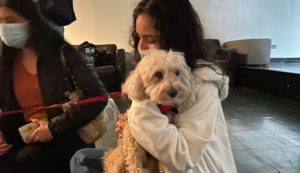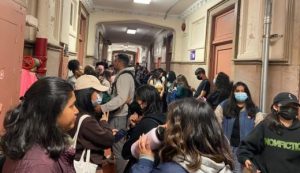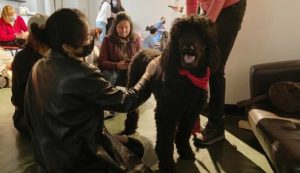
Five little pups were assigned one big task: help students stop stressing out during finals.
The line to see the therapy dogs inside the Thomas Hunter building last Wednesday wrapped around the hot, stuffy overcrowded first-floor hallway. Some were fanning themselves with papers to cool down, and others, including Marla Herrand and Xaona Sanchez decided to leave. But on their way out, they spotted 10-year-old toy poodle Melodie through the door. Immediately, they spun on their heels and found their places back in the crowd. They returned smiling, “Never mind we’re staying.”
The hosts, the Psychology Collective, kept a log of people attending. Ten-minute time slots, groups of four per dog, shifting every two minutes so each group can pet each of the five dogs. That was at first. But any semblance of structure was completely abandoned as shifts turned to just 60 seconds per group to accommodate the almost 200 students that showed.

Even members of the Undergraduate Student Government felt compelled to step in and help delegate the overwhelming turnout. Junior senator Ariana Ahmed and president Devashish Basnet were among them. “I saw they were getting a little bit disoriented by the number of people,” said Ahmed.
President of Psych News Jackson Rasenberger didn’t at all expect this many students to show. “It got to be so hectic that eventually we just kind of said, ‘To hell with the signup sheets.’” They adapted to what he called a ‘free-for-all format,’ letting people in once they get the chance. Students could hear the Psychology Collective’s phone alarms going off every other minute to keep track of slots and rotations.
All five dogs were brought in by their owners through New York Therapy Animals. The pups go through seven weeks of training classes to become certified therapy dogs.

Arguably the most dignified was 11-year-old Tasso, named after the Italian renaissance poet. At one point his owner Carol Wasserman stood up, and Tasso proceeded to shove his head through her legs. “He’s a standard poodle,” Wasserman said, “But I’ve decided he’s a superior poodle.”
Some students took a liking to six-year-old Olive. A rescue dog from Mexico, she ironically doesn’t like the heat but loves the snow, according to her owner Julia Pettiecord.
The youngest of the bunch was surprisingly one of the bigger-sized pups, Lila. Only three years old, Lila is a white labrador retriever that often laid on her back for tummy rubs from students. Though Marla Herrand, a junior, suspected it was because she was tired of all the people.
Herrand noted that the main enjoyment of the event stemmed from getting to see both friends and animals as a whole. “I haven’t seen a dog or interacted with a dog in a long time,” they said. “It was definitely beautiful in all aspects of it.”
The effects of the dogs on the students were very clear to Tasso’s owner. “It does make a difference,” Wasserman said, “Even if they don’t want to touch, just look at them.”
One thing’s for sure, the dogs got students and everyone else involved to think about something other than school stress.

Vice President of the Psychology Collective Aysha Khan thought many students would show, but wasn’t expecting just how many that did. “We were expecting a bigger turnout than most of our events,” she said, “So this is really pleasing.”
And the enthusiasm was widespread. Junior senator Ariana Ahmed said that getting students to take a short break from their studies to see the dogs goes a long way, emphasizing that Hunter is “definitely in need of more community events.”
Rasenberger called the turnout crazy, extending his thanks to USG for helping them organize. He hoped that students leave the event happier. Looking around he said, “It seems that they are.”
One nine-year-old poodle, April, spent most of the session sitting on students’ laps and licking their faces to the disapproval of her owner. “Don’t let her lick you! And I don’t want you to lick her,” she joked.
Before seeing the dogs, Xaona Sanchez was thinking about all the work she had to do that day. But getting to engage with friends and the experience as a whole left a visible difference in her stress levels. She recalled walking out of the event and rolling her tensed shoulders back only to find the tension was gone. “There was nothing there,” she said.

